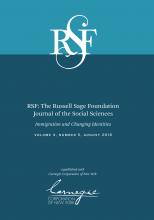Abstract
How do schools teach American identity in light of immigration-driven diversity? This ethnographic study focuses on everyday nation-making at Castro Middle School, located in a city transformed by immigration. Building on theories of bidirectional assimilation, I show how assimilation can produce new definitions of Americanness more recognizable to immigrant communities, facilitating their national identification. At Castro, bidirectional assimilation supported African American students’ descriptions of Americans in multicultural terms and their own identification as American. Assimilation between the school and the larger Latino and Asian student populations, however, was limited because of a binary racial paradigm that excluded them from the national community. This study thus nuances the role of race as a barrier in the assimilation process, particularly as it unfolds in schools.
- © 2018 Russell Sage Foundation. Lash, Cristina L. 2018. “Making Americans: Schooling, Diversity, and Assimilation in the Twenty-First Century.” RSF: The Russell Sage Foundation Journal of the Social Sciences 4(5): 99–117. DOI: 10.7758/RSF.2018.4.5.05. Sincere thanks are due to the National Academy of Education/Spencer Foundation, the Research Institute of Comparative Studies in Race and Ethnicity, the Stanford Graduate School of Education, and the Stanford Office of the Vice Provost for Graduate Education for sponsoring this research. Direct correspondence to: Cristina L. Lash at cristinalash{at}stanford.edu, 485 Lasuen Mall, Stanford, CA 94305.
Open Access Policy: RSF: The Russell Sage Foundation Journal of the Social Sciences is an open access journal. This article is published under a Creative Commons Attribution-NonCommercial-NoDerivs 3.0 Unported License.






